One method is the difference of row numbers approach to get the sequences for each:
select pid, count(*) as in_a_row, sum(val1_dur) as dur
from (select t.*,
row_number() over (partition by pid order by idx) as seqnum,
row_number() over (partition by pid, val3_bool order by idx) as seqnum_d
from consecutive t
) t
group by (seqnun - seqnum_d), pid, val3_bool;
If you are looking specifically for "1" values, then add where val3_bool = 1 to the outer query. To understand why this works, I would suggest that you stare at the results of the subquery, so you can understand why the difference defines the consecutive values.
You can then get the max using distinct on:
select distinct on (pid) t.*
from (select pid, count(*) as in_a_row, sum(val1_dur) as dur
from (select t.*,
row_number() over (partition by pid order by idx) as seqnum,
row_number() over (partition by pid, val3_bool order by idx) as seqnum_d
from consecutive t
) t
group by (seqnun - seqnum_d), pid, val3_bool;
) t
order by pid, in_a_row desc;
The distinct on does not require an additional level of subquery, but I think that makes the logic clearer.

